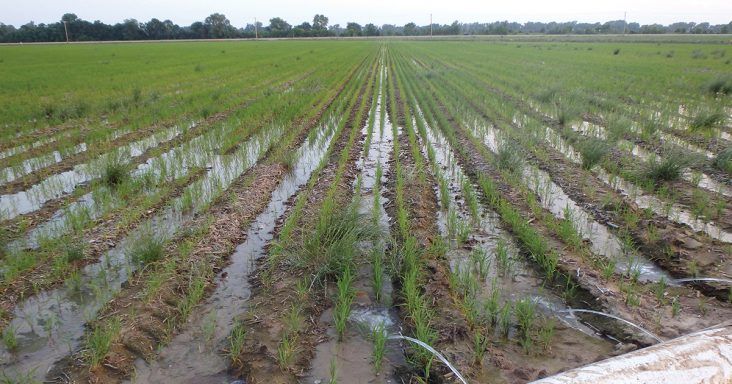Barry could devastate Arkansas’ rice crop
by July 13, 2019 9:36 pm 1,433 views

Photo courtesy of UA System Division of Agriculture.
Arkansas’ rice crop, delayed by a wet spring and bludgeoned by high heat, is now facing a triple threat from Tropical Storm Barry, whose remnants are expected to drop heavy rain on the eastern side of the state on Sunday (July 14). The National Hurricane Center on Thursday (July 11) showed potential rainfall totals ranging from 4 to 10 inches in eastern Arkansas, with the higher amounts expected closer to the Mississippi River.
“Barry has the potential to dump inches of rain during flowering and heading – rain which will disrupt pollination,” said Jarrod Hardke, extension rice agronomist for the University of Arkansas System Division of Agriculture. “We’re very vulnerable at this point, particularly as the plants begin flowering.”
“A little wind is good — we like to have pollen on the move because it means improved chances for pollination and grain fill. But if we get excessive winds and heavy rains during this period, particularly during the middle of the day, it’s bad news. It’s not that common in July, but you can end up blanking out entire panicles from severe wind and rain,” Hardke added.
Heavy rains present an additional concern.
“All that moisture will further aid disease development such as sheath blight and blast,” Hardke said.
The third worry is whatever strength Barry still might be packing when the storm sweeps into Arkansas. Strong winds could cause early lodging. Lodging is a condition in which the plant’s stalks start to lean or are flattened, which makes the grain difficult to harvest.
The National Oceanic and Atmospheric Administration reported Tuesday (July 9) that July 2018 through June 2019 represented the wettest 12 months on record for the 48 contiguous states, with an average rainfall of more than 37.8 inches — 7.9 inches above average. According to the National Weather Service, several cities had unrelenting rains n June. West Memphis saw 186% of its normal rainfall, Pine Bluff had 110% of its normal rainfall, and Little Rock had 123% of its normal June rainfall. On the flipside, Jonesboro came in at 91% of normal.
“The weather is very much an unknown,” Hardke said. “One of the problems with the sporadic thunderstorms this time of year is that they pop up in the middle of the day when plants are actively attempting to flower. If a storm hits around 4 p.m., it’s not that big of a deal — most of the flowering for that day is complete. But noon is the worst possible time for a storm to hit rice in this stage.”
Aside from storms, growers will also be keeping an eye on nighttime temperatures.
“Once we pass flowering, and get into the grain fill stage, the concern is the nighttime temperatures getting too high,” Hardke said. “It can lead to chalky rice kernels, rather than translucent. It’s just not as desirable an appearance, although it doesn’t necessarily change how the rice cooks or eats. In extreme cases, it can lead to yield losses.”
